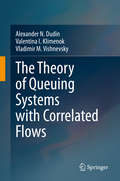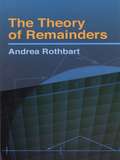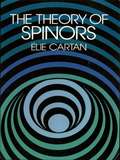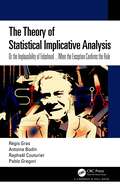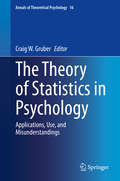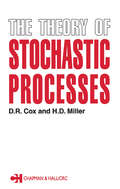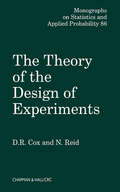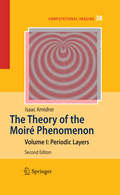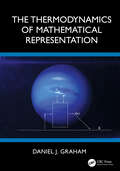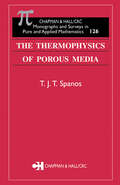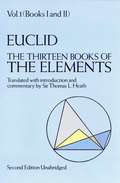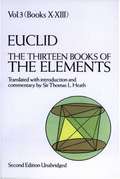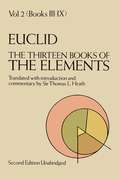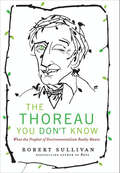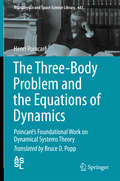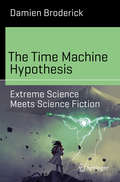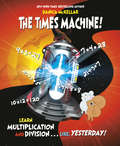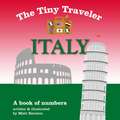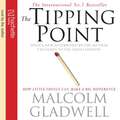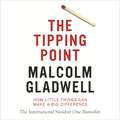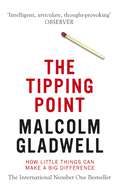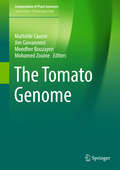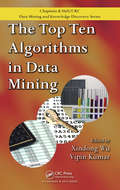- Table View
- List View
The Theory of Queuing Systems with Correlated Flows
by Alexander N. Dudin Valentina I. Klimenok Vladimir M. VishnevskyThis book is dedicated to the systematization and development of models, methods, and algorithms for queuing systems with correlated arrivals. After first setting up the basic tools needed for the study of queuing theory, the authors concentrate on complicated systems: multi-server systems with phase type distribution of service time or single-server queues with arbitrary distribution of service time or semi-Markovian service. They pay special attention to practically important retrial queues, tandem queues, and queues with unreliable servers. Mathematical models of networks and queuing systems are widely used for the study and optimization of various technical, physical, economic, industrial, and administrative systems, and this book will be valuable for researchers, graduate students, and practitioners in these domains.
The Theory of Remainders
by Andrea RothbartAn imaginative introduction to number theory, this unique approach employs a pair of fictional characters, Ant and Gnam. Ant leads Gnam through a variety of theories, and together, they put the theories into action--applying linear diophantine equations to football scoring, using a black-magic device to simplify problems in modular structures, and developing intriguing modifications to the rules of chess.Appropriate for anyone familiar with algebra at the high-school level, The Theory of Remainders offers a captivating introduction to both number theory and abstract algebra. Both elementary and challenging, it provides a view of mathematics as a conceptual net and illustrates the differences between conceptual and paraconceptual claims--an excellent start to expanding students' perspectives on mathematics.Exercises throughout the book form an integral part of the text, extending students' experience with the concepts under discussion and presenting opportunities to observe patterns. In addition to the exercises, a series of optional problems allows more advanced readers to further develop the concepts.
The Theory of Spinors
by Élie CartanThe French mathematician Élie Cartan (1869-1951) was one of the founders of the modern theory of Lie groups, a subject of central importance in mathematics and also one with many applications. In this volume, he describes the orthogonal groups, either with real or complex parameters including reflections, and also the related groups with indefinite metrics. He develops the theory of spinors (he discovered the general mathematical form of spinors in 1913) systematically by giving a purely geometrical definition of these mathematical entities; this geometrical origin makes it very easy to introduce spinors into Riemannian geometry, and particularly to apply the idea of parallel transport to these geometrical entities.The book is divided into two parts. The first is devoted to generalities on the group of rotations in n-dimensional space and on the linear representations of groups, and to the theory of spinors in three-dimensional space. Finally, the linear representations of the group of rotations in that space (of particular importance to quantum mechanics) are also examined. The second part is devoted to the theory of spinors in spaces of any number of dimensions, and particularly in the space of special relativity (Minkowski space). While the basic orientation of the book as a whole is mathematical, physicists will be especially interested in the final chapters treating the applications of spinors in the rotation and Lorentz groups. In this connection, Cartan shows how to derive the "Dirac" equation for any group, and extends the equation to general relativity.One of the greatest mathematicians of the 20th century, Cartan made notable contributions in mathematical physics, differential geometry, and group theory. Although a profound theorist, he was able to explain difficult concepts with clarity and simplicity. In this detailed, explicit treatise, mathematicians specializing in quantum mechanics will find his lucid approach a great value.
The Theory of Statistical Implicative Analysis: Or the Implausibility of Falsehood ... When the Exception Confirms the Rule
by Pablo Gregori Régis Gras Antoine Bodin Raphaël CouturierThis book summarizes the methods and concepts of Statistical Implicative Analysis (SIA), created by Régis Gras in the 1980s to study, in a new way, the behavioural responses of French pupils to mathematics tests. Using a multidimensional, non-symmetrical data analysis method, SIA crosses a set of subjects or objects with a set of variables. It effectively complements traditional correlational and psychometric methods. SIA, through its various extensions, is today presented as a broad Artificial Intelligence method aimed at extracting trends and possible causalities in the form of rules, from a set of variables. It is based on the unlikeliness of the existence of these relationships, i.e. on the relative weakness of their counter-examples compared to what chance alone would produce. It establishes a dual topological relationship between the set of subjects and the set of variables. Many applications of this approach, driving forces or crucibles for the development of SIA, have concerned and still concern various fields such as didactics, evaluation and assessment, psychology, sociology, medicine, biology, economics, art history, and others. Key Features: Presents the foundations and representations of SIA. Provides extensions of variable sets and subjects. Includes a bonus exercise.
The Theory of Statistics in Psychology: Applications, Use, and Misunderstandings (Annals of Theoretical Psychology #16)
by Craig W. GruberThis edition of Annals of Theoretical Psychology focuses on the utilization of statistics and the empirical nature of them as applied to psychology in action. Beginning with statements from the American Statistical Association on the applicability of statistics, the volume moves to a discussion of empiricism in psychology, and the reliance on statistics. The book then branches out to discuss applied aspects of statistics in Emergency management, policing, and technology. In these areas, a tie-in to the relevance of the person in the statistical measures is a prominent aspect for discussion. Finally, the book looks at applicability and use of statistics as descriptors of larger, societal samples as opposed to use for describing individual behavior. This edition is designed to continue the exploration of theoretical psychology as it applies to behavior and the individual, as the last edition, Leader Development Deconstructed, did with examining leaders and leadership."Leaders influence others. Their tools include competence, candor and character. In those first two areas I’ve found statisticians possess a strong foundation for leadership (critical thinking, problem solving, strategic perspective, and risk management) but often lack a comfortable, collaborative temperament which inhibits their maximum effect. In this issue of Annals, Dr. Craig Gruber (a Navy Reserve Intelligence Officer to boot!) combines all three elements of influence which proves why he is regarded as a thought leader in this field. His inclusion in this edition of outstanding works from many subject matter experts’ offers an inclusive and comprehensive approach to understanding the power, impact, and decision advantage of statistics and leadership when effectively paired. Enjoy!"- Rear Admiral Paul Becker, USN (retired), President of The Becker T3 Group, and former Director of Intelligence for the Joint Chiefs of Staff
The Theory of Stochastic Processes
by D.R. CoxThis book should be of interest to undergraduate and postgraduate students of probability theory.
The Theory of the Design of Experiments (Chapman & Hall/CRC Monographs on Statistics and Applied Probability)
by D.R. Cox Nancy ReidWhy study the theory of experiment design? Although it can be useful to know about special designs for specific purposes, experience suggests that a particular design can rarely be used directly. It needs adaptation to accommodate the circumstances of the experiment. Successful designs depend upon adapting general theoretical principles to the spec
The Theory of the Moiré Phenomenon
by Isaac AmidrorThis book presents the most comprehensive and methodical work on the theory of the moiré phenomenon, providing a full general-purpose and application-independent exposition of this fascinating effect. Based on the Fourier theory, it leads the reader through the various phenomena which occur in the superposition of repetitive layers, both in the image and in the spectral domains. The first chapters of the book present the basic theory, covering the superposition of monochrome, periodic layers. In later chapters, the theory is extended to the even more interesting cases of polychromatic moirés and moirés between repetitive, non-periodic layers. Throughout the whole text the book favours a pictorial, intuitive approach, which is supported by mathematics, and the discussion is accompanied by a large number of figures and illustrative examples. The prerequisite mathematical background is limited to an elementary familiarity with the Fourier theory.
The Thermodynamics of Mathematical Representation
by Daniel J. GrahamThermodynamics is the physical science surrounding work, heat, and relationships across fundamental quantities, and situates itself near the center of multiple disciplines through its generality and timelessness. Its laws required no rewriting after the twentieth century revolutions of quantum mechanics, relativity, and solid state physics, just to name three subjects. The nine chapters of this book make appeal to thermodynamic notions and laws to get under the hood of mathematics—the language of the physical sciences—without just echoing things best said and written in math books. It takes a system to learn about another system—we all need thermometers, voltmeters, and other gadgets to get to know objects of interest. But just as critical are the numbers and functions we put to the task, however relegated they are to computers in the modern day for the heavy lifting. To be sure, mathematical representations like x = ½, 5.2, π, e, etc., and f(x) = x2, sin(x), etc., are never in physical contact with the solids, liquids, and gases that draw our attention, but they are as impacted by the same natural laws as the lab apparatus itself.This book shows how the thermodynamic laws impact our number systems. The laws affirm that we have direct access to a vanishingly small fraction of the real numbers. They further establish that the real numbers present a maximum-evolved system impacting all matters of computation, graphing, differentiation, and integration. For completeness, one of the chapters includes cases where the thermodynamic laws have little, if anything, constructive to say about representations in mathematics.This book presents a novel perspective to students and teachers in the physical sciences, biology, and mathematics, with the goal of enriching classroom and seminar hours. The chapters are self-contained and written informally, and readers with rudimentary knowledge of energy, numbers, and functions should handle the material well.
The Thermophysics of Porous Media (Monographs and Surveys in Pure and Applied Mathematics)
by T.J.T. SpanosModels for the mechanical behavior of porous media introduced more than 50 years ago are still relied upon today, but more recent work shows that, in some cases, they may violate the laws of thermodynamics. In The Thermophysics of Porous Media, the author shows that physical consistency requires a unique description of dynamic processes that involv
The Thirteen Books of the Elements (Dover Books on Mathematics #1)
by EuclidThis is the definitive edition of one of the very greatest classics of all time — the full Euclid, not an abridgement. Using the text established by Heiberg, Sir Thomas Heath encompasses almost 2,500 years of mathematical and historical study upon Euclid.This unabridged republication of the original enlarged edition contains the complete English text of all 13 books of the Elements, plus a critical apparatus that analyzes each definition, postulate, and proposition in great detail. It covers textual and linguistic matters; mathematical analyses of Euclid’s ideas; classical, medieval, Renaissance, modern commentators; refutations, supports, extrapolations, reinterpretations, and historical notes, all given with extensive quotes.“The textbook that shall really replace Euclid has not yet been written and probably never will be.” — Encyclopaedia Britannica.Volume 1. 151-page Introduction: life and other works of Euclid; Greek and Islamic commentators; surviving mss., scholia, translations; bases of Euclid’s thought. Books I and II of the Elements, straight lines, angles, intersection of lines, triangles, parallelograms, etc.
The Thirteen Books of the Elements, Vol. 3 (Dover Books on Mathematics #3)
by EuclidThis is the definitive edition of one of the very greatest classics of all time—the full Euclid, not an abridgement. Utilizing the text established by Heiberg, Sir Thomas Heath encompasses almost 2500 years of mathematical and historical study upon Euclid.This unabridged republication of the original enlarged edition contains the complete English text of all 13 books of the Elements, plus a critical apparatus which analyzes each definition, postulate, and proposition in great detail. It covers textual and linguistic matters; mathematical anayses of Euclid's ideas; classical, medieval, Renaissance, modern commentators; refutations, supports, extrapolations, reinterpretations, and historical notes, all given with extensive quotes.
The Thirteen Books of the Elements: Books Iii-ix (classic Reprint) (Dover Books on Mathematics #2)
by EuclidThis is the definitive edition of one of the very greatest classics of all time — the full Euclid, not an abridgement. Using the text established by Heiberg, Sir Thomas Heath encompasses almost 2,500 years of mathematical and historical study upon Euclid.This unabridged republication of the original enlarged edition contains the complete English text of all 13 books of the Elements, plus a critical apparatus that analyzes each definition, postulate, and proposition in great detail. It covers textual and linguistic matters; mathematical analyses of Euclid’s ideas; classical, medieval, Renaissance, modern commentators; refutations, supports, extrapolations, reinterpretations, and historical notes, all given with extensive quotes. Volume 1. 151-page Introduction: life and other works of Euclid; Greek and Islamic commentators; surviving mss., scholia, translations; bases of Euclid’s thought. Books I and II of the Elements, straight lines, angles, intersection of lines, triangles, parallelograms, etc.Volume 2. Books III-IX: Circles, tangents, segments, figures described around and within circles, rations, proportions, magnitudes, polygons, prime numbers, products, plane and solid numbers, series of rations, etc.Volume 3. Books X to XIII: planes, solid angles, etc.; method of exhaustion in similar polygons within circles, pyramids, cones, cylinders, spheres, etc. Appendix: Books XIV, XV, sometimes ascribed to Euclid.
The Thoreau You Don't Know: What the Prophet of Environmentalism Really Meant
by Robert "Sully" SullivanRobert Sullivan, the New York Times bestselling author of Rats and Cross Country, delivers a revolutionary reconsideration of Henry David Thoreau for modern readers of the seminal transcendentalist. Dispelling common notions of Thoreau as a lonely eccentric cloistered at Walden Pond, Sullivan (whom the New York Times Book Review calls “an urban Thoreau”) paints a dynamic picture of Thoreau as the naturalist who founded our American ideal of “the Great Outdoors;” the rugged individual who honed friendships with Ralph Waldo Emerson and other writers; and the political activist who inspired Martin Luther King, Jr., Mahatma Gandhi, and other influential leaders of progressive change. You know Thoreau is one of America’s legendary writers…but the Thoreau you don’t know may be one of America’s greatest heroes.
The Three-Body Problem and the Equations of Dynamics
by Henri Poincaré Bruce D PoppHere is an accurate and readable translation of a seminal article by Henri Poincaré that is a classic in the study of dynamical systems popularly called chaos theory. In an effort to understand the stability of orbits in the solar system, Poincaré applied a Hamiltonian formulation to the equations of planetary motion and studied these differential equations in the limited case of three bodies to arrive at properties of the equations’ solutions, such as orbital resonances and horseshoe orbits. Poincaré wrote for professional mathematicians and astronomers interested in celestial mechanics and differential equations. Contemporary historians of math or science and researchers in dynamical systems and planetary motion with an interest in the origin or history of their field will find his work fascinating.
The Time Machine Hypothesis: Extreme Science Meets Science Fiction (Science and Fiction)
by Damien BroderickEvery age has characteristic inventions that change the world. In the 19th century it was the steam engine and the train. For the 20th, electric and gasoline power, aircraft, nuclear weapons, even ventures into space. Today, the planet is awash with electronic business, chatter and virtual-reality entertainment so brilliant that the division between real and simulated is hard to discern. But one new idea from the 19th century has failed, so far, to enter reality—time travel, using machines to turn the time dimension into a two-way highway. Will it come true, as foreseen in science fiction? Might we expect visits to and from the future, sooner than from space? That is the Time Machine Hypothesis, examined here by futurist Damien Broderick, an award-winning writer and theorist of the genre of the future. Broderick homes in on the topic through the lens of science as well as fiction, exploring some fifty different time-travel scenarios and conundrums found in the science fiction literature and film.
The Times Machine!: Learn Multiplication and Division. . . Like, Yesterday!
by Danica McKellarLearn at home with help from The Wonder Years/Hallmark actress, math whiz, and New York Times bestselling author Danica McKellar using her acclaimed McKellar Math books! A revolutionary and FUN way for 2nd to 5th graders to memorize multiplication facts outside of the classroom is finally here!Join Mr. Mouse and Ms. Squirrel and experience an entirely new way of memorizing multiplication facts. Using colorful stories, silly rhymes, and more, Danica McKellar helps to break down the rules of multiplication and to translate many of the (often confusing!) multiplication and division methods taught in today's classrooms. This lively "times" travel adventure is a lifesaver for frustrated kids and parents everywhere and a great way to "zero out" worries about homework and tests. If Mr. Mouse can learn to have fun with math, anyone can!
The Tiny Traveler: A Book of Numbers
by Misti KenisonHow many gondolas float down the canal? Can you count the number of masks at Carnival? Toddlers will answer these questions and more in this new book from Misti Kenison in her Tiny Traveler series. Travel from Rome to Venice as you and your little one count your way through Italy’s most famous landmarks. From one leaning tower to seven fresh pizzas coming out of the oven, you’ll catch the travel bug while teaching children the basics of counting!The fourth book in Kenison’s Tiny Traveler board book series will exposure your child to another country and culture while teaching him or her the basic concept of counting and numbers. So sit back and explore the world with your little one from your very own living room. Traveling to foreign places has never been so fun, or educational, for young children before!A wonderful series for young toddlers (0 to 2 years), this book teaches the basic concept of numbers and counting. Can be used at home or in a childcare facility to teach basic concepts.
The Tipping Point: How Little Things Can Make a Big Difference
by Malcolm Gladwell'A wonderful page-turner about a fascinating idea that should affect the way every thinking person thinks about the world around him' Michael LewisIn this brilliant and original book, Malcolm Gladwell explains and analyses the 'tipping point', that magic moment when ideas, trends and social behaviour cross a threshold, tip and spread like wildfire. Taking a look behind the surface of many familiar occurrences in our everyday world, Gladwell explains the fascinating social dynamics that cause rapid change.'Hip and hopeful, THE TIPPING POINT is like the idea it describes: concise, elegant but packed with social power. A book for anyone who cares about how society works and how we can make it better' George Stephanopoulos
The Tipping Point: How Little Things Can Make a Big Difference
by Malcolm Gladwell'A wonderful page-turner about a fascinating idea that should affect the way every thinking person thinks about the world around him' Michael LewisIn this brilliant and original book, Malcolm Gladwell explains and analyses the 'tipping point', that magic moment when ideas, trends and social behaviour cross a threshold, tip and spread like wildfire. Taking a look behind the surface of many familiar occurrences in our everyday world, Gladwell explains the fascinating social dynamics that cause rapid change.'Hip and hopeful, THE TIPPING POINT is like the idea it describes: concise, elegant but packed with social power. A book for anyone who cares about how society works and how we can make it better' George Stephanopoulos
The Tipping Point: How Little Things Can Make a Big Difference
by Malcolm Gladwell'A wonderful page-turner about a fascinating idea that should affect the way every thinking person thinks about the world around him' Michael LewisIn this brilliant and original book, Malcolm Gladwell explains and analyses the 'tipping point', that magic moment when ideas, trends and social behaviour cross a threshold, tip and spread like wildfire. Taking a look behind the surface of many familiar occurrences in our everyday world, Gladwell explains the fascinating social dynamics that cause rapid change.'Hip and hopeful, THE TIPPING POINT is like the idea it describes: concise, elegant but packed with social power. A book for anyone who cares about how society works and how we can make it better' George Stephanopoulos
The Tomato Genome
by Mathilde Causse Mondher Bouzayen Jim Giovannoni Mohamed ZouineThis book describes the strategy used for sequencing, assembling and annotating the tomato genome and presents the main characteristics of this sequence with a special focus on repeated sequences and the ancestral polyploidy events. It also includes the chloroplast and mitochondrial genomes. Tomato (Solanum lycopersicum) is a major crop plant as well as a model for fruit development, and the availability of the genome sequence has completely changed the paradigm of the species' genetics and genomics. The book describes the numerous genetic and genomic resources available, the identified genes and quantitative trait locus (QTL) identified, as well as the strong synteny across Solanaceae species. Lastly, it discusses the consequences of the availability of a high-quality genome sequence of the cultivated species for the research community. It is a valuable resource for students and researchers interested in the genetics and genomics of tomato and Solanaceae.
The Top Ten Algorithms in Data Mining (Chapman & Hall/CRC Data Mining and Knowledge Discovery Series)
by Vipin Kumar Xindong WuIdentifying some of the most influential algorithms that are widely used in the data mining community, The Top Ten Algorithms in Data Mining provides a description of each algorithm, discusses its impact, and reviews current and future research. Thoroughly evaluated by independent reviewers, each chapter focuses on a particular algorithm and is wri
The Topological Imagination: Spheres, Edges, and Islands
by Angus FletcherIn a bold and boundary defining work, Angus Fletcher clears a space for an intellectual encounter with the shape of human imagining. Joining literature and topology—a branch of mathematics—he maps the ways the imagination’s contours are formed by the spherical earth’s patterns and cycles, and shows how the world we inhabit also inhabits us.
The Topology of Chaos: Alice in Stretch and Squeezeland
by Robert Gilmore Marc LefrancA highly valued resource for those who wish to move from the introductory and preliminary understandings and the measurement of chaotic behavior to a more sophisticated and precise understanding of chaotic systems. <P><P>The authors provide a deep understanding of the structure of strange attractors, how they are classified, and how the information required to identify and classify a strange attractor can be extracted from experimental data. In its first edition, the Topology of Chaos has been a valuable resource for physicist and mathematicians interested in the topological analysis of dynamical systems. Since its publication in 2002, important theoretical and experimental advances have put the topological analysis program on a firmer basis. This second edition includes relevant results and connects the material to other recent developments. Following significant improvements will be included: * A gentler introduction to the topological analysis of chaotic systems for the non expert which introduces the problems and questions that one commonly encounters when observing a chaotic dynamics and which are well addressed by a topological approach: existence of unstable periodic orbits, bifurcation sequences, multistability etc. * A new chapter is devoted to bounding tori which are essential for achieving generality as well as for understanding the influence of boundary conditions. * The new edition also reflects the progress which had been made towards extending topological analysis to higher-dimensional systems by proposing a new formalism where evolving triangulations replace braids. * There has also been much progress in the understanding of what is a good representation of a chaotic system, and therefore a new chapter is devoted to embeddings. * The chapter on topological analysis program will be expanded to cover traditional measures of chaos. This will help to connect those readers who are familiar with those measures and tests to the more sophisticated methodologies discussed in detail in this book. * The addition of the Appendix with both frequently asked and open questions with answers gathers the most essential points readers should keep in mind and guides to corresponding sections in the book. This will be of great help to those who want to selectively dive into the book and its treatments rather than reading it cover to cover. What makes this book special is its attempt to classify real physical systems (e.g. lasers) using topological techniques applied to real date (e.g. time series). Hence it has become the experimenter?s guidebook to reliable and sophisticated studies of experimental data for comparison with candidate relevant theoretical models, inevitable to physicists, mathematicians, and engineers studying low-dimensional chaotic systems.
